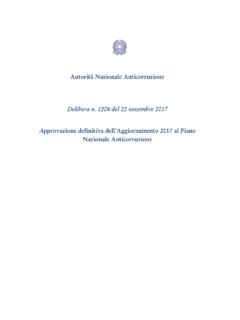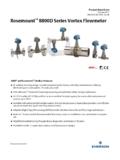Transcription of SHARC Processor ADSP-21161N - Analog Devices
1 SHARC Processor ADSP- 21161n . SUMMARY Integrated peripherals integrated I/O Processor , 1M bit on- chip dual-ported SRAM, SDRAM controller, glueless multi- High performance 32-Bit DSP applications in audio, medi- processing features, and I/O ports (serial, link, external cal, military, wireless communications, graphics, imaging, bus, SPI, and JTAG). motor-control, and telephony ADSP- 21161n supports 32-bit fixed, 32-bit float, and 40-bit Super Harvard Architecture four independent buses for floating-point formats dual data fetch, instruction fetch, and nonintrusive zero- overhead I/O 100 MHz/110 MHz core instruction rate Code compatible with all other SHARC family DSPs Single-cycle instruction execution, including SIMD opera- tions in both computational units Single-instruction multiple-data (SIMD) computational archi- tecture two 32-bit IEEE floating-point computation units, Up to 660 MFLOPs peak and 440 MFLOPs sustained each with a multiplier, ALU, shifter, and register file performance Serial ports offer I2S support via 8 programmable and simul- 225-ball 17 mm 17 mm CSP_BGA package taneous receive or transmit pins, which support up to 16.
2 Transmit or 16 receive channels of audio CORE Processor DUAL-PORTED SRAM. 6. TWO INDEPENDENT JTAG TEST. BLOCK 0. INSTRUCTION AND EMULATION. DUAL-PORTED BLOCKS. BLOCK 1. TIMER CACHE. 32 u 48-BIT Processor PORT I/O PORT. 12. GPIO. ADDR DATA DATA ADDR FLAGS. ADDR DATA DATA ADDR. DAG1 DAG2 8. PROGRAM SDRAM. 8 u 4 u 32 8 u 4 u 32 SEQUENCER CONTROLLER. IOD IOA EXTERNAL PORT. 32 64 18. ADDR BUS 24. PM ADDRESS BUS. 32 MUX. DM ADDRESS BUS. 64. BUS MULTIPROCESSOR. CONNECT PM DATA BUS INTERFACE. 64. (PX). DM DATA BUS. DATA BUS 32. MUX. DATA DATA. REGISTER REGISTER HOST PORT. FILE FILE. (PEX) (PEY). BARREL BARREL. 16 u 40-BIT SHIFTER SHIFTER 16 u 40-BIT. MULT MULT. DMA 5. IOP CONTROLLER. ALU ALU REGISTERS. 16. (MEMORY MAPPED) SERIAL PORTS (4). S. CONTROL, 20. STATUS, & LINK PORTS (2). DATA BUFFERS 4. SPI PORTS (1). I/O Processor . Figure 1. ADSP- 21161n Functional Block Diagram SHARC and the SHARC logo are registered trademarks of Analog Devices , Inc. Rev. C Document Feedback Information furnished by Analog Devices is believed to be accurate and reliable.
3 However, no responsibility is assumed by Analog Devices for its use, nor for any infringements of patents or other rights of third parties that may result from its use. Specifications subject to change without notice. No license is granted by implication One Technology Way, Box 9106, Norwood, MA 02062-9106 or otherwise under any patent or patent rights of Analog Devices . Trademarks and Tel: 2013 Analog Devices , Inc. All rights reserved. registered trademarks are the property of their respective companies. Technical Support ADSP- 21161n . TABLE OF CONTENTS. Summary .. 1 Absolute Maximum Ratings .. 19. General Description .. 3 ESD Caution .. 19. ADSP- 21161n Family Core Architecture .. 3 Timing Specifications .. 19. ADSP- 21161n Memory and I/O Interface Features .. 5 Power Dissipation .. 20. Development Tools .. 9 Output Drive Currents .. 54. Additional Information .. 10 Test Conditions .. 54. Related Signal Chains .. 10 Environmental Conditions .. 55. Pin Function Descriptions .. 11 225-Ball CSP_BGA Ball Configurations.
4 56. Boot Modes .. 16 Outline Dimensions .. 58. Specifications .. 17 Surface-Mount Design .. 58. Operating Conditions .. 17 Ordering Guide .. 58. Electrical Characteristics .. 18. Package Information .. 19. REVISION HISTORY. 1/13 Rev. B to Rev. C. Updated Development Tools .. 9. Added section, Related Signal Chains .. 10. Added footnote 3 to Table 16 in Memory Read Bus Master .. 27. Rev. C | Page 2 of 60 | January 2013. ADSP- 21161n . GENERAL DESCRIPTION. The ADSP- 21161n SHARC DSP is a low cost derivative of the The block diagram of the ADSP- 21161n on Page 1 illustrates ADSP-21160 featuring Analog Devices Super Harvard Archi- the following architectural features: tecture. Easing portability, the ADSP- 21161n is source code Two processing elements, each made up of an ALU, multi- compatible with the ADSP-21160 and with first generation plier, shifter, and data register file ADSP-2106x SHARC processors in SISD (Single-Instruction, Single-Data) mode. Like other SHARC DSPs, the ADSP- Data address generators (DAG1, DAG2).
5 21161n is a 32-bit Processor that is optimized for high perfor- Program sequencer with instruction cache mance DSP applications. The ADSP- 21161n includes a PM and DM buses capable of supporting four 32-bit data 100 MHz or 110 MHz core, a dual-ported on-chip SRAM, an transfers between memory and the core every core proces- integrated I/O Processor with multiprocessing support, and sor cycle multiple internal buses to eliminate I/O bottlenecks. Interval timer As was first offered in the ADSP-21160, the ADSP- 21161n . offers a single-instruction multiple-data (SIMD) architecture. On-Chip SRAM (1M bit). Using two computational units (ADSP-2106x SHARC proces- SDRAM controller for glueless interface to SDRAMs sors have one), the ADSP- 21161n can double cycle External port that supports: performance versus the ADSP-2106x on a range of DSP. algorithms. Interfacing to off-chip memory peripherals Fabricated in a state of the art, high speed, low power CMOS Glueless multiprocessing support for six process, the ADSP- 21161n has a 10 ns or 9 ns instruction cycle ADSP- 21161n SHARCs time.
6 With its SIMD computational hardware running at Host port read/write of IOP registers 110 MHz, the ADSP- 21161n can perform 660 million floating- point operations per second. Table 1 shows performance bench- DMA controller marks for the ADSP- 21161n . Four serial ports These benchmarks provide single-channel extrapolations of Two link ports measured dual-channel processing performance. For more SPI compatible interface information on benchmarking and optimizing DSP code, for both single and dual-channel processing, see the Analog Devices JTAG test access port Inc. website. 12 general-purpose I/O pins Figure 2 shows a typical single- Processor system. A multipro- Table 1. Benchmarks cessing system appears in Figure 5 on Page 8. 100 MHz 110 MHz ADSP- 21161n FAMILY CORE ARCHITECTURE. Instruction Instruction Benchmark Algorithm Rate Rate The ADSP- 21161n includes the following architectural features 1024 Point Complex FFT 92 s s of the ADSP-2116x family core. The ADSP- 21161n is code (Radix 4, with Reversal) compatible at the assembly level with the ADSP-21160, ADSP-21060, ADSP-21061, ADSP-21062, and ADSP-21065L.
7 FIR Filter (Per Tap) 5 ns ns IIR Filter (Per Biquad) 20 ns ns SIMD Computational Engine Matrix Multiply (Pipelined) The ADSP- 21161n contains two computational processing ele- [3 3] [3 1] 45 ns ns ments that operate as a single-instruction multiple-data (SIMD). [4 4] [4 1] 80 ns ns engine. The processing elements are referred to as PEX and Divide (y/x) 60 ns ns PEY, and each contains an ALU, multiplier, shifter, and register file. PEX is always active, and PEY may be enabled by setting the Inverse Square Root 40 ns ns PEYEN mode bit in the MODE1 register. When this mode is DMA Transfers 800M bytes/s 880M bytes/s enabled, the same instruction is executed in both processing ele- ments, but each processing element operates on different data. The ADSP- 21161n continues SHARC 's industry-leading stan- This architecture is efficient at executing math intensive DSP. dards of integration for DSPs, combining a high performance algorithms. 32-bit DSP core with integrated, on-chip system features.
8 These Entering SIMD mode also has an effect on the way data is trans- features include a 1M bit dual ported SRAM memory, host pro- ferred between memory and the processing elements. When in cessor interface, I/O Processor that supports 14 DMA channels, SIMD mode, twice the data bandwidth is required to sustain four serial ports, two link ports, SDRAM controller, SPI inter- computational operation in the processing elements. Because of face, external parallel bus, and glueless multiprocessing. this requirement, entering SIMD mode also doubles the bandwidth between memory and the processing elements. Rev. C | Page 3 of 60 | January 2013. ADSP- 21161n . When using the DAGs to transfer data in SIMD mode, two data Data Register File values are transferred with each access of memory or the regis- A general-purpose data register file is contained in each pro- ter file. cessing element. The register files transfer data between the SIMD is supported only for internal memory accesses and is not computation units and the data buses, and store intermediate supported for off-chip accesses.
9 Results. These 10-port, 32-register (16 primary, 16 secondary). register files, combined with the SHARC enhanced Harvard Independent, Parallel Computation Units architecture, allow unconstrained data flow between computa- Within each processing element is a set of computational units. tion units and internal memory. The registers in PEX are The computational units consist of an arithmetic/logic unit referred to as R0 R15 and in PEY as S0 S15. (ALU), multiplier, and shifter. These units perform single-cycle instructions. The three units within each processing element are Single-Cycle Fetch of Instruction and Four Operands arranged in parallel, maximizing computational throughput. The ADSP- 21161n features an enhanced Harvard architecture Single multifunction instructions execute parallel ALU and in which the data memory (DM) bus transfers data and the pro- multiplier operations. In SIMD mode, the parallel ALU and gram memory (PM) bus transfers both instructions and data multiplier operations occur in both processing elements.
10 These (see Figure 2). With the ADSP- 21161n 's separate program and computation units support IEEE 32-bit single-precision float- data memory buses and on-chip instruction cache, the proces- ing-point, 40-bit extended precision floating-point, and 32-bit sor can simultaneously fetch four operands (two over each data fixed-point data formats. bus) and an instruction (from the cache), all in a single cycle. CONTROL. ADDRESS. ADSP- 21161n . CLOCK. CLKIN DATA. XTAL. 2. CLK_CFG1-0 BMS CS. CLKDBL BOOT. EBOOT ADDR EPROM. LBOOT (OPTIONAL). 3 BRST DATA. IRQ2-0. 12. FLAG11-0 ADDR23-0 ADDR. TIMEXP. RPBA DATA47-16 DATA MEMORY. ID2-0 AND. RD OE. LINK PERIPHERALS. LXCLK WR WE (OPTIONAL). Devices . LXACK ACK ACK. (2 MAX). (OPTIONAL) LXDAT7-0 MS3-0 CS. SCLK0 RAS RAS. SERIAL. FS0 CAS CAS SDRAM. DEVICE. (OPTIONAL) D0A DQM DQM (OPTIONAL). D0B. SDWE WE. SCLK1 SDCLK1-0 CLK. SERIAL FS1 SDCKE CKE. DEVICE D1A. (OPTIONAL) SDA10 A10. D1B CS. ADDR. SCLK2. SERIAL DATA. FS2. DEVICE CLKOUT. (OPTIONAL) D2A. D2B DMAR2-1.
















